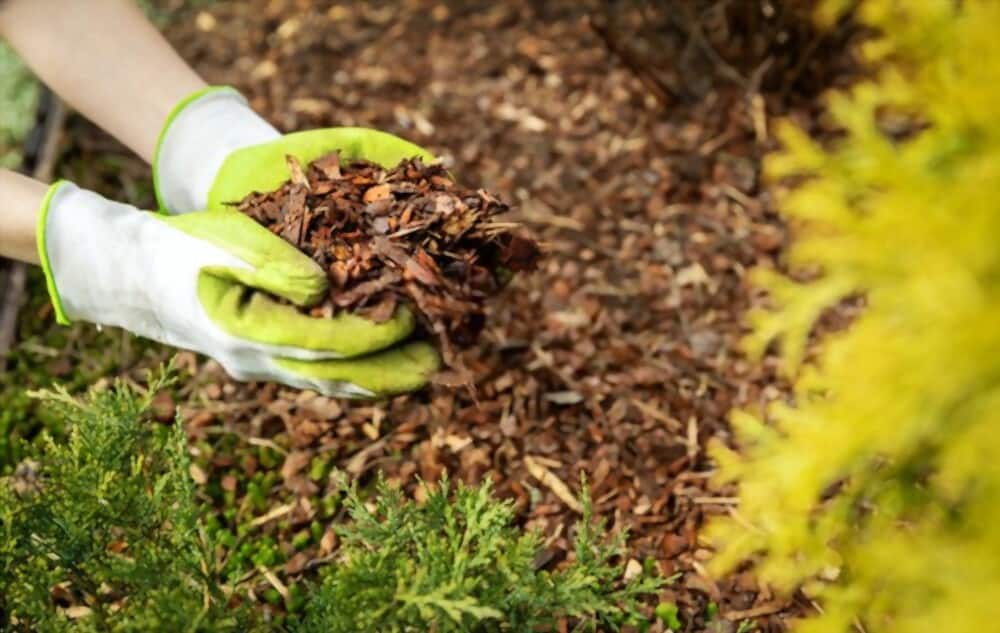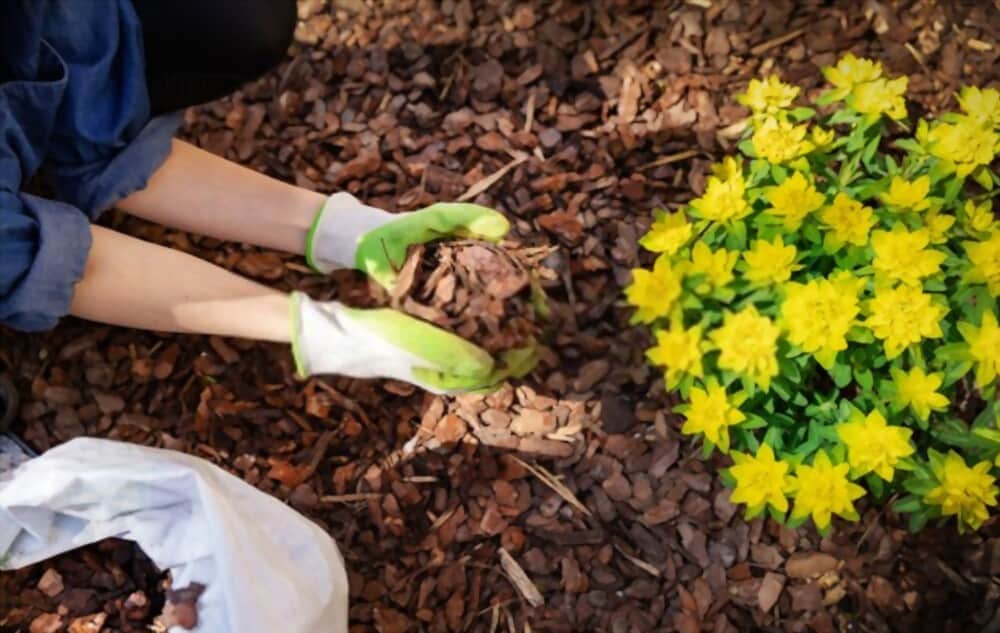
Mulch is a fantastic weed- and soil-control tool. You must learn how to prevent mulch from losing its color, though.
By: 1. constantly turning and mixing it, and 2. adding fresh mulch on top of old, mulch can keep its color. 3. Using artificial mulch 4. Moderate watering 5. Protecting the mulch from the weather
When the color deteriorates, mulch can also be coloured with mulch dyes.
Your mulch can keep its color in a variety of ways. What kind of mulch you have and how much you want to invest will determine the strategy you choose. I’ll discuss a variety of techniques in this article that can prevent your mulch from losing its color.
Table of Contents
Why Does Mulch Lose its Color?
In this world, everything has a shelf life, including mulch—but only if it is not properly maintained. One of the numerous causes of this issue is that excessive sunshine exposure will have a detrimental impact on the mulch.
Essentially a bleaching agent, sunlight. Mulch’s color will deteriorate as a result of exposure to sunshine; this process is called “photodegradation.”
That is why you should periodically check on the mulch.
But wasn’t the purpose of mulching in the first place to shield the soil from the sun? It is present for that purpose, yes.
Mulch can only perform as intended if it is continuously maintained. If not, it will continue to function for approximately 4 to 5 months or for a whole year, depending on the kind of mulch you pick.
The mulch may still allow some weeds to pass through and grow on it, which could be the second explanation.
Mulch’s functionality will be badly impacted by this in addition to the fact that its color will begin to fade. To keep things moving smoothly and maintain the mulch’s color, experts advise replacing or adding mulch over the old one.
Which Mulch Fades the Fastest?
Mulch that is organic or natural ages more quickly than mulch made of synthetic materials.
The reason is that you are well aware that organic mulch, such as leaves or wood chips, loses its color more quickly. The leaves turn yellow and the color of the wood chips begins to deteriorate.
Though it is better for your soil than synthetic mulches, this does not imply that you should never use organic mulch.
As organic mulches decompose, they can enrich the soil with organic matter. They can also be incorporated into the soil to hasten the process.
Which Color of Mulch Fades The Least?
The least fading mulch is artificial. In comparison to biological mulches, rubber, plastic, and painted stones typically remain longer since the colors used can endure changing weather conditions for extended periods of time. Mulch’s ability to retain color can be increased by keeping it protected.
Some of these mulches will eventually lose their color, even when the most durable color is used. Natural mulches are among those that fade the quickest, as you’ve read.
The mulch’s color will deteriorate more quickly the more natural it is. Therefore, to avoid this, think about choosing mulches that are colored a dark shade of brown or black.
You won’t have to be concerned about color fading for at least a year if you do this. Because of this, most gardeners prefer to use colored mulches, such as black or brown, rather than traditional natural mulches.
Tips for Maintaining Mulch Color
The mulch’s color is fading, and you need to take quick action to prevent the issue because this could indicate that the mulch is deteriorating. Let’s investigate your options for handling it.
1. Turn and Mix the Mulch
This is something you should do every year because it is one of the simpler methods. To make the mulch appear more recent and fresh, you would have to flip it over or do whatever is required.
The mulch’s believability will then be extended for a while as the bottom, which was previously shielded from the sun, is now exposed to it.
2. Reduce Mulch Exposure to Mulching
That’s accurate. Reduce the amount of mulching the mulch is exposed to, which means only exposing the mulch to the sun when absolutely necessary.
To put it another way, protect and shield the mulch from light in some way to maintain its color. In this manner, the color will probably continue to be vibrant for longer.
3. Avoid Flooding and Excess Water
Watering the mulch is beneficial and necessary, but that doesn’t mean you should water it excessively just to have the greatest mulch possible.
This hypothesis that water should constantly be provided as mulch’s requirement is also supported by research. Therefore, you can employ this method to reduce the likelihood of mulch color loss.
4. Apply a Layer of New Mulch Over Old Mulch
This is the most suggested and efficient technique to maintain the mulch’s color and keep it looking new throughout.
To replace the old, deteriorating mulch, you simply need to use some new mulch or a layer of it. The mulch will begin to look new and fresh, as you might expect.
There is one thing to keep in mind here, and that is to avoid adding too much fresh mulch to the existing one. As you are surely aware:
Mulch should be around 3 inches thick or dense, give or take.
If you make it any thicker than that, you won’t have simple access to the necessary sunlight, moisture, or oxygen. Alternatively, if you make it even thinner, the cannabis (weed) plants will pierce through the mulch and continue to thrive.
5. Use Rubber or Synthetic Mulch
Rubber mulch is the best option if you want to kill the nib before it forms a bud. The color of rubber mulch, an artificial mulch produced from rubber, does not deteriorate with time. Rubber mulch, on the other hand, is equally appropriate for your soil because it can perform all the functions of a natural mulch.
The point is not that it is without its ups and downs. Rubber mulch is the ideal solution if all that matters to you is preventing the color of the mulch from fading.
6. Spray the Mulch with Dye
It is simple to rejuvenate old mulch by adding dyes to it after it has been let to sit for some time rather than having to remove it and replace it with new mulch, which can be expensive.
When used properly, dyes can extend the life and vibrancy of mulch. This can be done using a cheap garden sprayer, as we’ll cover later in this article.
Can You Spray Paint Old Mulch to Look New?
You can, indeed. It works well to make the mulch appear newer and more vibrant. There are various mulch paints on the market that are made specifically to be sprayed on the older mulch.
This paint is made by combining color and water, and it is then sprayed over the mulch to prevent it from losing its color.
Spray all you want, but there’s no getting around the fact that you’re only enhancing its appearance and not its health.
In other words, instead of addressing the issue, you are spraying to cover it up. Your mulch will be impacted by it, and it will eventually weaken.
Using Colorant to Dye Mulch
Using mulch dye is possible. Restores faded mulch’s color and instantly improves curb appeal, adding to the savings from not having to replace the mulch.
Plants should always be protected by being wrapped in fabric or plastic. A barricade should be placed around the location as well.
Begin on one side of the plant or flower bed, work your way across the bed, and finish on the opposite side. This stops the disruption of recently colored mulch.
The majority of mulch dyes call for a single application, but we’ve discovered that two applications can make the color last even longer.
We advise using a darker-colored dye if you want a longer-lasting result. Maybe one with a darker tone of chocolate.
Is Dyed Mulch Better than normal Mulch?
When used, the colored mulch has a nice appearance, but it is not the best option for your soil. During its lifetime, the colored mulch will perform exactly like the regular mulches.
It will prevent weed growth, maintain soil moisture, and save moisture. But it won’t decompose in order to combine with the soil and be beneficial to it.
This mulch’s painted color is artificial, therefore it will ultimately fade and disappear after it loses its usefulness.
The color, which contains a number of hazardous substances, will therefore come into touch with the soil as you slide off the mulch, and you already know that this is not a good thing to happen.
How Do You Keep Mulch Looking Fresh? (without dye)

The freshness is temporary and will disappear gradually. However, there are certain techniques to make sure your mulch looks, if not remains, fresh.
Because they have an additional layer of protection from the sun, inorganic mulches or coloured mulches have a tendency to stay fresh for an extended period of time.
What can you do, then? The simplest solution would be to cover the previous mulch with a fresh layer of mulch. However, if it’s too late. If the previous mulch cannot be saved, it is time to totally remove it and replace it with new mulch.
Additionally, you can look for any unusual weed growth near or on the mulch. They may also make mulches look less appealing. If you come across those weeds, get rid of them right away. Or you can cover the weeds with more mulch to prevent further growth.
To give it a new and fresh look, you might even completely blend the old and new mulch. Apply a strong mulch barrier to keep your mulch from washing away.
People may believe that because they have used the thickest mulch possible, no wind can damage or uproot them, but if the mulch is not used properly, winds can occasionally ruin them.
Use of mulches that are somewhat heavier is therefore required. This problem primarily manifests itself in hilly regions where the wind pressure is greater.
The Takeaway
The mulch’s color will eventually fade no matter what you do because it must. Spraying, stirring, or mixing the mulch are good but short-term fixes.
Decide on the permanent one. In this case, the best course of action is to use natural mulch.
It shouldn’t be too difficult to replace or change the mulch once every three to four years, right? You will preserve your soil and avoid the extra difficulties associated with other approaches if you do this.
Please leave a remark below to share your thoughts on how long we should continue utilizing the same mulch. If you have any additional queries about mulch, you can also leave a remark below.
